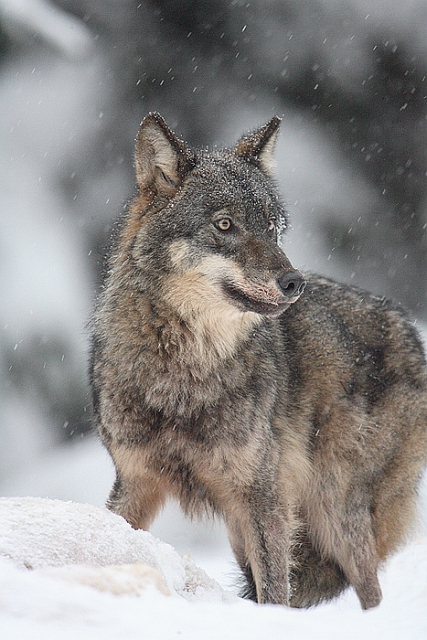The wolf – best-known animal in Estonian folklore
Photo: Valeri Štšerbatõh, http://foto.dvaa.ee/
Translation: Liis
Läänemaa, December 2010
Wolf researcher Ilmar Rootsi says that our ancestors considered the animal of the year, the wolf, the streak-eye, to be the most important animal in the forests.
As far back in time as the folklore of our people goes – some of it even back to prehistoric times – nothing hostile towards the wolf is found in it. On the contrary. We expected protection and aid from him, regardless of the losses that he caused and the misdeeds that he committed. We have never hanged wolves as was the case in Germany and France. We have never skinned them alive, burnt them alive, gouged out their eyes, as was done in Russia in the past.
The wolf lore of Estonians is rich and varied, we have nearly 500 euphemisms for him (kriimsilm, hallivatimees, võsavillem, pajuvasikas etc*). He must be kept away from cattle herds, but was granted the right to live. It was believed that if a wolf killed an animal in a herd this brought fertility; belief in a similar positive effect has not been noted for foxes or bears.
In Estonian folk traditions wolves have a very special position among wild animals. In hunter and fisher cultures the wolf did not by far have the importance that he has had in field cultivating and cattle raising cultures. Thus the Estonian traditions that tell about wolves have evolved largely in a cattle-raising social context, since all possible means were employed to attempt to keep away the wolves, that were a constant threat to the herds, from the cattle. The domestic animals were the only wealth of our ancestors, on which to a great extent their life and existence depended. This is also confirmed by Gressel’s "Eesti-ma rahwa kalender ehk täht-ramat – Estonian folk calendar” (Tallinn, 1838; 20 pp) published in 1839 where it is written: "Cattle is the wealth of the peasant, and so it is not to be wondered at that he diligently cares for them [---] how to protect the herd from harm and how to encourage its fertility”. Valuable cattle were protected by physical measures (smearing with birch tar, paraffin oil, even gunpowder) as well as with magic (enchantments and spells). The wolf’s right to live was always recognized. Relying on the magic effect of the power of words and on the belief that the wolf was easily persuaded, could so to say be "talked off”, a shepherd turns to the wolf with the following words, in a spell documented in 1894 from the Vigala parish: "Metsa sikku, metsa sokku, metsa kuldane kuningas, metsa halli harvalõuga, metsa peni pikkalõuga! Ära salva salajalta, ära näksa nägemata, ära puutu minu pulli, ära katsu minu karja! Mine sohu sobistama, mine laande luusimaie, pikki puida murdemaie, kivi külga kiskumaie!” **(Vigala parish, collected by M. Aitsam, 1834).
The wolf was also an animal of omen: from its howl, visit in a village or in a farmstead yard, an encounter with it on a road, seeing it actually or in a dream the weather, harvest, man’s own and his herd’s future was foretold.
The wolf is an important animal in Estonian folk traditions in general. Even the frequent occurrence of the words ’hunt’–’hundi’, ’susi’ –’soe’*** in the usage of language bears witness to his importance in the life of people. Thus the wolf has prevailed in the minds and deeds of our ancestors for centuries as a perfect predator, physically strong, tough and vital, an alert and intelligent being. Man in turn has not left the wolf unchanged, influencing him to become ecologically more adaptable; the outcome can be expressed with a well-known Estonian proverb: "The wolf has one man’s strength but nine men’s mind.“
Ilmar Rootsi’s article was published in the journal „Loodusesõber“ in the October (Mud Month) issue, No. 5, 2012..
Notes:
* Streakeye, greycoatman, copse William, willow calf
** "Billygoat of the forest, goat of the forest, golden king of the forest, grey scarce-hair chin of the forest, long-jaw hound of the forest! Do not inject poison stealthily, do not bite unseen, do not touch my ox, do not touch my herd! Go waddle in bogs, go rove in forests, slay along trees, tear at stones.“
*** Hunt is traditionally the Northern Estonian word for wolf. Susi has dominated in the south. Hunt is most common today.
The names and chants do not rely only on the dictionary meanings of the words, but their rhythm, sounds, in particular allitterations, and associations. A translation only conveys a small part of the power and charge of these strings of words.
Ilmar Rootsi's full article, in Estonian, see www.loodusesober.ee/
.









